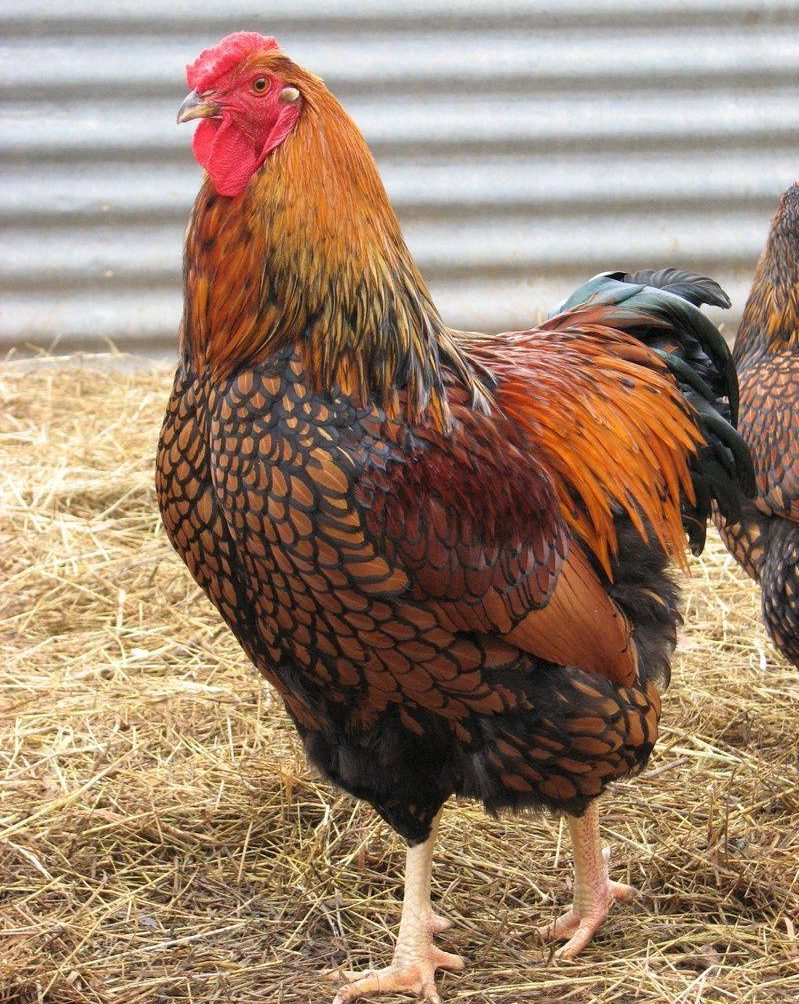A versatile, all-American breed with a friendly personality and nice egg laying abilities, a Golden Laced Wyandotte is an excellent choice for a backyard or small homestead flock.
When you add in the fact that their plumage practically glows in the morning sunlight, you may write Golden Wyandottes at the top of the list of new breeds to try when you are choosing your spring chicks at the feed store.
These birds are eye-catching with showy plumage and all the curves that you could wish for in a chicken.
Golden Laced Wyandotte
When you are deciding whether a particular breed of chicken is right for your set-up, it helps to do a bit of research on the breed’s origins. When you know why old time farmers developed a breed, you can correlate the original breeder’s needs with what you are looking for.
Breed Origin
This bird was the first new chicken breed developed in the United States. In the 1870s, chicken breeders in extreme northern New York State and Ontario, Canada developed the Wyandotte chicken.
These farmers were looking for a versatile chicken with good egg laying abilities and large enough to supply meat for the table. They also wanted one that was hardy, self-sufficient, and handled the extreme winter cold of these northern climates well.
While the exact birds used to create this cross are somewhat mysterious, poultry historians believe that Dark Brahma and Silver Hamburgs were used, along with a few other breeds.
These first chickens were called American Sebrights. Soon, the name was changed to Wyandottes in honor of the Native American tribes that lived in those areas of the continent.
The original Wyandotte chickens were of the silver laced color combination. These birds had mostly gray-silver coloration, but each feather was outlined in a black “lacing” or edging. This led to birds that had a lovely mottled appearance.
The chickens provided exactly what the breeders were looking for.
Breeders soon crossed these birds with other chicken breeds to develop various colors and color patterns. Soon there were Wyandottes in buff, white, black, and blue. The second color pattern developed in Wyandottes after the silver laced color was the golden laced color pattern. Learn about the Blue Laced Red Wyandotte chicken.
Breeders crossed a Silver Laced Wyandotte with Golden Spangled Hamburg and Partridge Cochin chickens. These birds developed feathers that were a rich gold color with a delicate black laced edging.
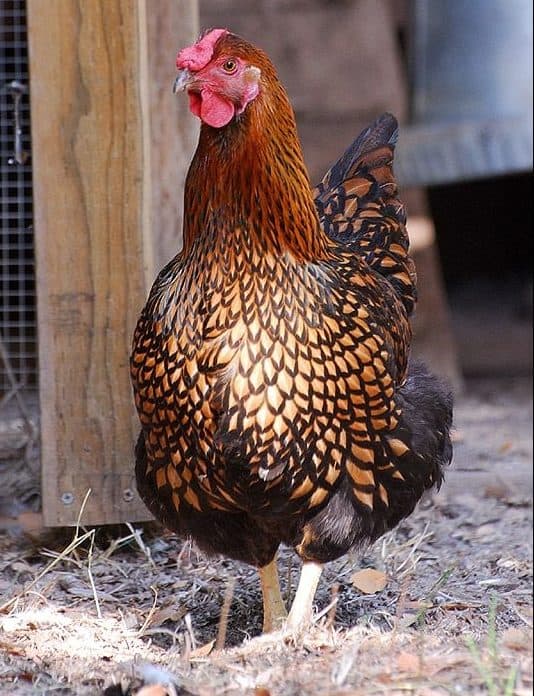
Best Uses for Golden Laced Wyandottes
Like many chickens with origins in the 1800s, Golden Laced Wyandottes are considered dual-purpose chickens. Back when these chickens were bred, farmers didn’t keep separate flocks of chickens for eggs and meat.
They wanted chickens that were good, reliable layers whose roosters would dress out to a decent size for table meat. They also wanted hens who would yield good-sized carcasses when their laying days were done.
Chickens that were rather independent did well on frontier farms since farmers had no time to coddle hens who needed special care and feed.
Farmers wanted chickens who would forage and scratch for themselves during the warm months. They also wanted chickens who stayed in good condition without intensive management.
The Golden Laced Wyandotte fits all of these criteria, making them definitely fit into the dual purpose chicken category.
The hens lay fairly well and are healthy, independent birds. The roosters grow rather quickly into birds that dress out well for table meat. Older hens will make a respectable pot of dumplings or chicken soup.
Please note that the Golden Laced Wyandotte yields meat that has yellow skin, so you may want to keep that in mind if the skin color is important to you or those to whom you are marketing meat.
Golden Laced Personality
Gold Laced Wyandottes have personalities that many hen keepers love. They are assertive birds that seem quite talkative and noisy. This can be an asset to keepers who enjoy the sounds of the barnyard. Those who live in subdivisions or have neighbors nearby and may need a quieter bird might want to consider a different breed.
Golden Wyandottes are rather independent. They enjoy foraging and caring for themselves. While they are not usually mean or aggressive to humans, they are definitely confident birds. They may not take on the personality of barnyard bully, but they might outcompete very docile birds in the flock for food and water.
Just keep an eye on a mixed flock to make sure that all of your chickens are getting what they need and that the establishing of the pecking order doesn’t get out of hand.
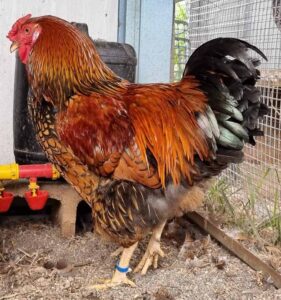
Golden Laced Wyandottes love their humans. You may be able to teach them to come when you call them and take chicken scratch from your hands. However, they don’t always turn into pets that can be picked up, carried, and cuddled.
If handling your chickens is important to you, know that you will be taking your chances when you buy Golden Laced Wyandotte chickens. Sometimes, especially if you handle your Golden Laced Wyandottes frequently when they are young, you may be able to make a lap pet from this breed of chicken.
General Appearance and Size
The Golden Wyandotte is available in both standard size and bantam size. Standard Golden Wyandotte hens weigh about 6 to 7 pounds while the bantam hen weighs about 24 ounces.
A standard Golden Wyandotte rooster weighs about 7 to 8 pounds while the bantam version of these roosters weighs about 26 ounces.
Both the standard and bantam versions of the Golden Laced Wyandotte feature the same body features and color patterns. The bantam is simply a miniature version of the standard chicken.
Golden Laced Wyandottes are very curvy birds. Their backs feature a deep arch from the back of the neck to the tail of the bird, giving almost a deep U shape to the body.
Both the hens and the roosters have gorgeous rose combs, ear lobes, and wattles.
The flatter surface of the rose comb allows the birds to tolerate cold weather very well. Both sexes have clean legs which are yellow, which is the breed standard. They have yellow beaks.
Golden Laced Wyandotte hens have rather short necks and broad bodies with perky tails. Roosters are a little more upright and definitely more muscular and masculine in appearance.
The eyes of both hens and roosters of this breed are a deep bay red and are alert and curious. The Golden Laced is liberally feathered, making the birds appear larger than what they actually are.
Feathers
The distinctive feathering pattern varies a bit between hens and roosters. For both sexes, the basic background color of the bird is a rich brownish gold. Their heads are generally more golden in color than the rest of their bodies. The feathering on the body features black edging on the feathers giving the birds a mottled, speckled appearance.
Generally, the lacing pattern on the feathers is more visible on the hens than on the roosters. A Golden Laced Wyandotte rooster has a bright golden head and neck. The feathering on the body shows the distinctive lacing pattern with a golden triangular wing. His tail feathers are a deep greenish black, sprouting in a fountain shape from the rear end of the bird.
Pullets and Hens
Pullets are what poultry experts call young hens that have not yet begun to lay eggs reliably. For the Golden Laced Wyandotte breed, hens start laying around the age of 18 to 20 weeks. This may be somewhat younger than some other breeds of hens, particularly breeds that are comparable in size to the Wyandotte.
The Golden Laced Wyandotte hen will lay an egg almost every other day during most of the year. She may take some time off in the dark winter months if you don’t supply supplemental lighting. They will stop laying as well when they molt in the spring and fall.
Golden Laced Wyandotte Roosters
Golden Laced roosters are large, powerful birds, but they have relatively mellow personalities. Of course, individual roosters can vary in personality, but most of the time, these roosters are not very aggressive, particularly toward humans.
However, until you are certain about your particular Golden Laced Wyandotte rooster, keep an eye on small dogs, cats, and small children around the roosters, just in case for safety’s sake. They are excellent protectors of the flock. They will chase and flap at anything they might perceive as a threat.
Like other breeds of chickens, when your young roosters begin to experience puberty, they will probably start behaving with much more assertiveness toward the hens, and particularly toward the other roosters.
Most of the time, they will settle down after a few weeks when the roosters figure out which one is the biggest and the strongest. Be sure to keep one rooster for every 8 – 10 hens to minimize stress on the hens and competition with the roosters.
Usually, Golden Laced Wyandotte roosters will reach sexual maturity around 16 to 20 weeks of age. If you are raising the roosters for meat, this is the ideal time at which you can butcher them. They will have reached most of their adult size, but their meat will still be tender and delicious.
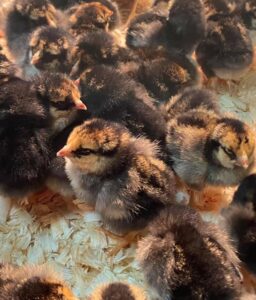
Chicks
Golden Laced Wyandotte chicks are brown and black. Generally, their breasts and heads are brown or grayish with black wings and tails. Their bodies are covered in soft, fluffy down feathers, which quickly is replaced by regular feathers as they grow.
Some chicken breeds have chicks that are hatched with the males featuring one color pattern and the females featuring a different pattern. These birds are called sex linked and with these breeds it is very easy to buy exactly the sex of chickens that you want.
Golden Wyandotte chicks are not sex linked. This means if you want only hens or only roosters, you will need to rely on the hatchery to vent sex the chickens.
At the hatchery, a poultry expert will examine the vents of newly hatched chickens and sort the males from the females. However, this process can be imperfect. There is always a chance that you could end up with a rooster, even if you think you’ve only bought hens.
If you have some patience, you can wait about 4 to 6 weeks to sex your Golden Laced Wyandottes.
By the time your golden chicks are this age, you can check out the development of their combs and wattles to tell the boys from the girls. The male chicks will have more prominent combs and wattles than the females.
Buying from a Hatchery
You can buy Golden Laced Wyandotte chicks from the numerous hatcheries that are located around the United States. One advantage of buying from a hatchery is that you can call around and ask the managers about the specific strains that they have.
Some strains of chickens may have particular features that you want. If you do or don’t want hens that go broody more often, you can ask the producer what their breeding stock is like. If you want a strain that is less independent or is more friendly, you can ask multiple hatcheries about their hens.
Buying Chicks from a Farm or Feed Store
Another alternative is to buy chicks at a feed or farm store. When you do this, make sure that the place you are buying from has healthy, perky-looking chicks. Resist the urge to rehabilitate a chick that is looking sickly, since this almost never ends with a healthy chicken.
If the farm store doesn’t provide clean, well-tended brooders for their chicks, you probably want to find a place that takes better care of their animals. Small chicks could be incubating an illness that they caught from dirty or overcrowded brooders, and you don’t want to take a chance on that.
Egg Laying and Broodiness
Golden Laced Wyandotte hens are decent layers. They will lay 4 to 5 eggs per week during their peak egg production years. This translates to about 180 to 220 eggs per year, counting the time that they would spend in molting.
They will lay dependably for the first 3 to 4 years of their lives, but may taper off in laying as they age.
Wyandotte eggs are large. The standard sized Golden Laced Wyandotte lays a large, rich brown egg. Bantam Wyandottes lay eggs that are much smaller, about half the size of a standard sized chicken.
Because the Golden Laced Wyandotte is bred to handle severe cold, they seem to lay better than many other breeds during the cold winter months.
If you want to increase their laying in winter, you may want to provide a supplemental light source for 2 or 3 hours a day. Factor in where you live and how long the days are. They will need 10 to 12 hours of light to lay reliably in winter.
Golden Laced Wyandotte chickens, like many breeds created for small, frontier farms, are very good mothers. Those who bred these birds wanted hens who would incubate a clutch of eggs, hatch them out, and tend the chicks. This is what they got with this golden laced breed.
The Golden Laced Wyandotte isn’t as broody as some breeds, like the Silkie chicken or Orpington, but they do go broody fairly regularly, and when they do this they will be successful at it.
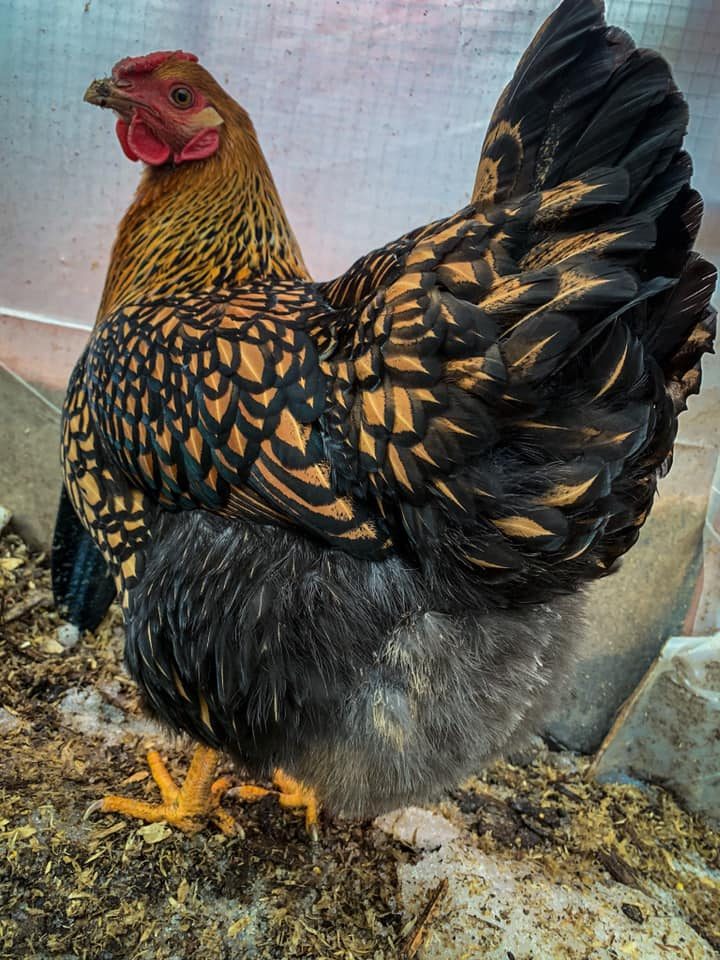
Caring for Golden Wyandottes
Golden Wyandottes are a breed of chickens that are easy to care for. They do require the basics that all chickens need. They need plenty of a balanced layer pellet, fresh water, and enough space.
Like all breeds, they require a chicken coop that is protected from predators. Be sure to have protection from the elements as well: rain, sleet, snow, and sun.
They are overall healthy birds. To keep common diseases at bay, keep up with cleaning the coop and be sure it’s well-ventilated. Avoid drafts in the cold months. In cold climates, the chickens will need to stay dry.
Because these lovely birds are a bit larger than some breeds, you may need to add a few extra roosts to allow for adequate roosting space.
Be sure to have enough nesting boxes as well. Hens will always have a favorite. Put out the chicken nesting boxes when they are of laying age. For Golden Laced, this will be when they are approximately 4.5 months old.
They do well in confinement as long as they have adequate space and a chicken run, but they also love to free-range. This will provide the added benefit of insect management.
Special Needs
The liberal plumage of the Golden Laced chickens presents its own special set of issues.
-
Lice
First, the numerous fluffy feathers may harbor lice that can bite and irritate the skin of your chickens. You should learn to check for these parasites every now and then. If your birds end up with lice, you can buy an insecticidal powder with which you can treat them. Giving confined birds several places to dust bathe can help reduce the instances of lice on your chickens.
-
Breeding
The second issue caused by the lovely, copious feathering of a Golden Laced Wyandotte is for those who wish to breed their chickens. The plentiful feathering around the vent of both hens and roosters may interfere with these birds’ mating.
If breeding the Wyandottes is important to you, you can take a pair of sharp scissors and trim the feathers away from their vents to help the chickens mate and create new generations of these chickens.
Some Golden Wyandottes may sport a single comb instead of a rose comb. This feature isn’t recommended if you want to breed Golden Laced chicks.
-
Cold Hardy, Not as Heat Tolerant
While Golden Laced Wyandottes are a hardy, easy to manage breed, you must keep in mind that they were bred for rather cool climates. Their dense feathering and under fluff provide extra insulation. Their rose combs lay close to their heads and aren’t as prone to frostbite.
While their cold hardiness is an asset in January, if you live in an area where the summers are long and hot, you may want to choose another breed. If you do have a hot spell, make sure that your chickens have plenty of access to deep shade and plenty of water.
Changing out their water for cool, fresh water multiple times a day can help them stay healthy and cool in the summer heat. You may even want to run a fan in their coop to prevent heat stress in the hot summer months.
Golden Laced Hens and Roosters
The Golden Laced Wyandotte is one of the 18 varieties of Wyandottes recognized for poultry exhibition. Golden Laced are hardy, beautiful chickens with stunning plumage of gold feathers and confident personalities. This chicken is a favorite of the show bird circuit.
Hens are reliable layers, and roosters will protect their flock.
Golden Laced Wyandotte chickens will earn their keep as utility chickens. They are great at providing a reliable, egg source. They lay large brown eggs — averaging 200 or more per hen — that you can enjoy all year. The hens and roosters dress out well. They provide a good amount of table meat for your family.
You can also keep them as pets when their egg laying utility ceases. They are overall friendly birds, well-mannered and docile. The roosters will vary. Some can be a bit aggressive, but others won’t be.
Gold Laced hens are moderate-to-high on the broodiness scale and can hatch their chicks. They make excellent mothers.
As these are larger birds, if you have limited space, consider raising Golden Laced Wyandotte bantams. This is a miniature size.
Add this American chicken breed to your backyard if you are a beginner chicken owner or a poultry pro. If you already have Silver Laced Wyandottes or other Wyandotte chickens, adding Gold Laced will add color variety to your flock. They have moderate aggression toward flock members.
Remember, they are noisy and like to chatter. Consider this if you have neighbors close by. The plus side is they are good foragers and can help with pest management.

